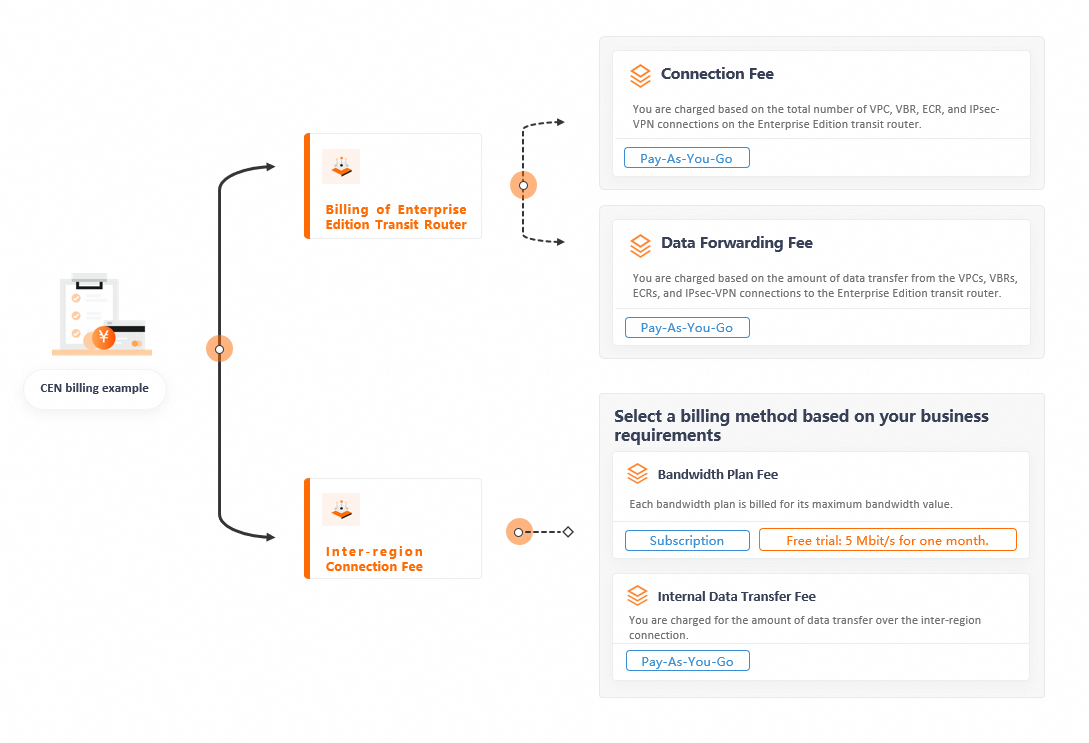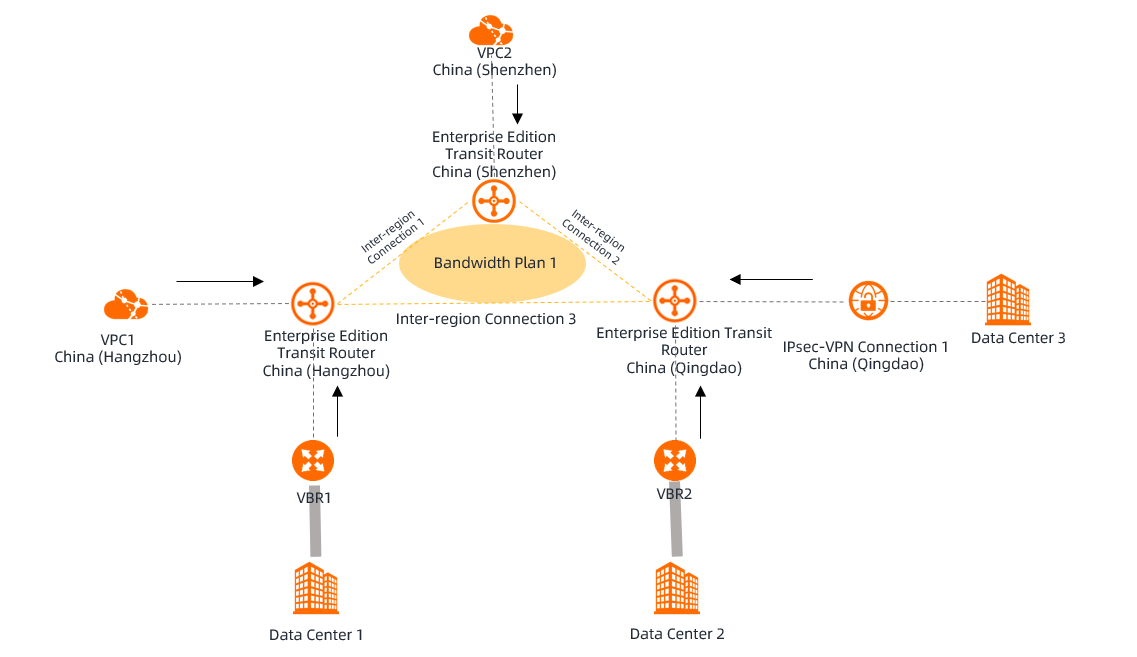You are charged fees when you use Enterprise Edition transit routers or Cloud Enterprise Network (CEN) to establish inter-region network communication. This topic describes the billable items and billing rules for CEN.
Billable items
The following figure shows the billable items of CEN.

Billable items
The following table describes the billable items, use scenarios, and billing rules of CEN.
Resource | Billable item | Use scenario | Billing rule |
Enterprise Edition transit routers | Connections | An Enterprise Edition transit router is connected to virtual private clouds (VPCs), virtual border routers (VBRs), Express Connect Routers (ECRs), or IPsec-VPN connections. | |
Data forwarding | An Enterprise Edition transit router forwards network traffic for VPCs, VBRs, ECRs, or IPsec-VPN connections. | ||
Inter-region connections | Bandwidth plans | Enable network communication between network instances in different regions. To allow network instances in different regions to communicate with each other, you must create inter-region connections between the regions. Bandwidth resources for inter-region connections can be allocated in the following modes. Select a mode based on your business requirements.
| |
Data transfer |
Beginning March 31, 2021, first-time users of Alibaba Cloud are eligible for free trials of CEN bandwidth plans. The duration of a free trial is one month, and the maximum bandwidth of a free-trial bandwidth plan is 5 Mbit/s. You can apply for a free trial. For more information, see CEN free trial.
Billing rules for Enterprise Edition transit routers
Billing rules
Billable item | Billing rule | Billing method | Billing cycle |
Connections | You are charged based on the total number of VPCs, VBRs, ECRs, and IPsec-VPN connections attached to your Enterprise Edition transit router. Connection fee of each Enterprise Edition transit router = Connection unit price (USD per connection-hour) × (Number of VPC connections on the transit router + Number of VBR connections on the transit router + Number of ECR connections on the transit router + Number of IPsec-VPN connections on the transit router) × Usage duration (hours). The usage duration refers to the total period of time from when a connection is created on the Enterprise Edition transit router to when the connection is closed on the Enterprise Edition transit router. | Pay-as-you-go. This billing method allows you to use resources before you pay for the resources. You are billed based on the resources that are consumed. | One hour. If the usage duration is less than 1 hour, it is rounded up to 1 hour. |
Data forwarding | You are charged based on the amount of data transfer from the VPCs, VBRs, ECRs, and IPsec-VPN connections to your Enterprise Edition transit router. Data forwarding fee of each Enterprise Edition transit router = Data forwarding unit price (USD/GB) × (Total amount of data transfer transmitted from the VPCs, VBRs, ECRs, and IPsec-VPN connections to the Enterprise Edition transit router). Data transfer from the Enterprise Edition transit router to the VPCs, VBRs, ECRs, and IPsec-VPN connections is free of charge. | One hour. |
Pricing of connections and data forwarding on transit routers
The pricing information in the following tables is for reference only. If the prices in the following tables are different from those on the buy page, the prices on the buy page shall prevail.
Area | Region | Connection fee (USD/hour/transit router) | Data forwarding fee (USD/GB) |
Chinese mainland | China (Hangzhou), China (Shanghai), China (Nanjing - Local Region), China (Fuzhou - Local Region), China (Shenzhen), China (Heyuan), China (Guangzhou), China (Qingdao), China (Beijing), China (Zhangjiakou), China (Hohhot), China (Ulanqab), and China (Chengdu) | 0.05 | 0.02 |
Asia Pacific | Singapore, China (Hong Kong), Malaysia (Kuala Lumpur), India (Mumbai), Indonesia (Jakarta), Philippines (Manila), Japan (Tokyo), South Korea (Seoul), and Thailand (Bangkok) | 0.06 | 0.02 |
Europe | Germany (Frankfurt) and UK (London) | 0.06 | 0.02 |
North America | US (Virginia) and US (Silicon Valley) | 0.06 | 0.02 |
Australia | Australia (Sydney) | 0.06 | 0.02 |
Middle East | SAU (Riyadh) | 0.06 | 0.02 |
Billing rules for inter-region connections
Billing rules
Bandwidth resources for inter-region connections can be allocated in two modes. Select a mode based on your business requirements. The billing rules of the bandwidth allocation modes are different.
Bandwidth allocation mode | Billable item | Billing rule | Billing method | Billing cycle | Use scenario |
Allocate bandwidth from bandwidth plans | Bandwidth plans | Before you can create an inter-region connection, you must purchase a bandwidth plan. Then, you can allocate bandwidth resources from the bandwidth plan to the inter-region connection. Each bandwidth plan is billed based on the maximum bandwidth. Bandwidth plan fee = Unit price (USD per Mbit/s-month) × Maximum bandwidth × Subscription duration (months). | Subscription. This billing method allows you to subscribe to bandwidth plans on a monthly or annual basis. You must pay for resources before you can use the resources. | One month | Ideal for long-term services with small traffic fluctuations, such as file transfer, data migration, and data synchronization. |
Pay-by-data-transfer | Data transfer | You are charged a data forwarding fee. When you create an inter-region connection, you can choose the Platinum or Gold line type. The unit price of data forwarding varies based on the line type. Data forwarding fees are managed by Cloud Data Transfer (CDT). For more information, see Inter-region data transfers. | Pay-as-you-go. This billing method allows you to use resources before you pay for the resources. You are billed based on the resources that are consumed. | One hour | Ideal for services with large traffic fluctuations and unpredictable bandwidth usage, such as temporary scale-outs, testing, video conferencing, and real-time gaming. |
Line types
Pay-by-data-transfer inter-region connections support the Platinum and Gold line types. If the bandwidth resources of an inter-region connection are allocated from a bandwidth plan, the inter-region connection uses the Gold line type by default. The data forwarding performance varies based on the line type.
Line type | Service availability | Use scenario |
Platinum | 99.995% | Ideal for services that require high network quality and are sensitive to network jitters and latency, such as securities transactions, online voice conferencing, online video conferencing, and real-time gaming. |
Gold | 99.95% | Ideal for services that do not have high requirements for network quality, such as data synchronization and file transfer. |
Pricing of bandwidth
The following table describes the prices of bandwidth in the Chinese mainland. For more information about the pricing of bandwidth in other areas, visit the buy page.
Bandwidth is billed based on a tiered pricing model. For example, Alice purchased a bandwidth plan that supports network communication in the Chinese mainland. The maximum bandwidth of the bandwidth plan is 110 Mbit/s, and the subscription duration is 1 month. The fee for the bandwidth plan is calculated based on the following formula:
USD 34 per Mbit/s-month × 100 Mbit/s × 1 (month) + USD 13 per Mbit/s-month × 10 Mbit/s × 1 (month) = USD 3,530
Connected areas | Bandwidth tier Unit: Mbit/s. | Bandwidth unit price Unit: USD per Mbit/s-month |
In the Chinese mainland | 0 to 100 (including 100) | 34 |
101 to 1,000 (including 1,000) | 13 | |
>1000 | 8 |
Pricing of data transfer
For more information, see Inter-region data transfers.
Billing examples
The following examples show the billing rules for CEN.

A company attached VPC1, VPC2, VBR1, VBR2, and IPsec-VPN Connection 1 to a CEN instance. The IPsec-VPN connection is an Internet connection. The company also purchased Bandwidth Plan 1 to establish network communication in the Chinese mainland. The maximum bandwidth of Bandwidth Plan 1 is 160 Mbit/s, and the subscription duration is 1 month. Bandwidth resources for Inter-region Connection 1, Inter-region Connection 2, and Inter-region Connection 3 are allocated from Bandwidth Plan 1. Network communication is established among the network instances attached to the CEN instance.
The following table describes the resources consumed by each network instance and inter-region connection in June 2022 (30 calendar days).
Network instance/Connection | Total duration of connection to the Enterprise Edition transit router | Total data transfer to the Enterprise Edition transit router |
VPC1 | 24 hours per day × 30 days = 720 hours | 20 GB of data transfer to the Enterprise Edition transit router in China (Hangzhou) |
VPC2 | 24 hours per day × 30 days = 720 hours | 20 GB of data transfer to the Enterprise Edition transit router in China (Shenzhen) |
VBR1 | 24 hours per day × 30 days = 720 hours | 30 GB of data transfer to the Enterprise Edition transit router in China (Hangzhou) |
VBR2 | 24 hours per day × 30 days = 720 hours | 30 GB of data transfer to the Enterprise Edition transit router in China (Qingdao) |
IPsec-VPN Connection 1 | 24 hours per day × 30 days = 720 hours | 40 GB of data transfer to the Enterprise Edition transit router in China (Qingdao) |
Inter-region connection | Maximum bandwidth | Connected regions | Bandwidth plan | Areas connected by the bandwidth plan |
Inter-region Connection 1 | 50 Mbit/s | China (Hangzhou) and China (Shenzhen) | Bandwidth Plan 1 | Within the Chinese mainland |
Inter-region Connection 2 | 100 Mbit/s | China (Shenzhen) and China (Qingdao) | Bandwidth Plan 1 | Within the Chinese mainland |
Inter-region Connection 3 | 10 Mbit/s | China (Hangzhou) and China (Qingdao) | Bandwidth Plan 1 | Within the Chinese mainland |
The following table describes the connection fee, data forwarding fee, and inter-region connection fee in June 2022.
Connection and data forwarding fees
Billable item | Connection fee | Data forwarding fee | Connection and data forwarding fee of each network instance |
VPC1 | USD 0.05 per connection-hour × 24 hours per day × 30 days × 1 connection = USD 36.00 | USD 0.02 per GB × 20 GB =USD 0.40 | USD 36.40 |
VPC2 | USD 0.05 per connection-hour × 24 hours per day × 30 days × 1 connection = USD 36.00 | USD 0.02 per GB × 20 GB =USD 0.40 | USD 36.40 |
VBR1 | USD 0.05 per connection-hour × 24 hours per day × 30 days × 1 connection = USD 36.00 | USD 0.02 per GB × 30 GB = USD 0.60 | USD 36.60 |
VBR2 | USD 0.05 per connection-hour × 24 hours per day × 30 days × 1 connection = USD 36.00 | USD 0.02 per GB × 30 GB = USD 0.60 | USD 36.60 |
IPsec-VPN Connection 1 | USD 0.05 per connection-hour × 24 hours per day × 30 days × 1 connection = USD 36.00 | USD 0.02 per GB × 40 GB = USD 0.80 | USD 36.80 |
Connection and data forwarding fees of all network instances | USD 180.00 | USD 2.80 | USD 182.8 |
Inter-region connection fee
Bandwidth resources for Inter-region Connection 1, Inter-region Connection 2, and Inter-region Connection 3 are allocated from Bandwidth Plan 1. Therefore, the company is charged only for Bandwidth Plan 1. The fee for Bandwidth Plan 1 is calculated based on the following formula:
USD 34 per Mbit/s-month × 100 Mbit/s × 1 month + USD 13 per Mbit/s-month × 60 Mbit/s × 1 month = USD 4,180
Total fee
The total fee in June 2022 is calculated based on the following formula: USD 182.80 + USD 4,180.00 = USD 4362.80